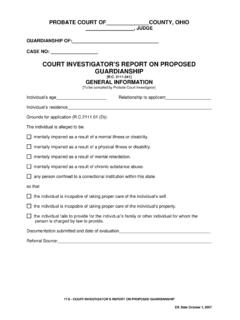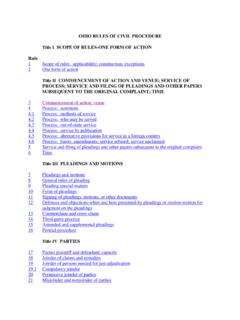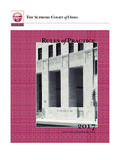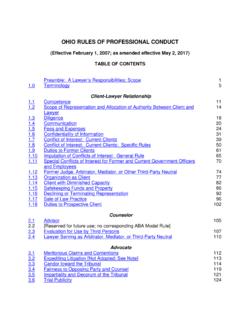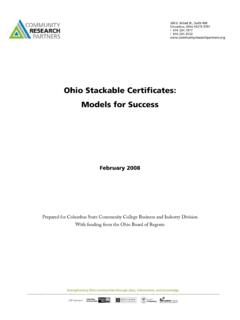Transcription of Watson v. Columbus State Community College
1 [Cite as Watson v. Columbus State Community College , 2016-Ohio-3037.] IN THE COURT OF APPEALS OF OHIO TENTH APPELLATE DISTRICT Yvonne Watson , : Appellant-Appellant, : No. 15AP-1009 ( No. 15CV-2640) v. : (ACCELERATED CALENDAR) Columbus State Community College , : Appellee-Appellee. : D E C I S I O N Rendered on May 17, 2016 On brief: William J. O'Malley, for appellant. Argued: William J. O'Malley. On brief: Michael DeWine, Attorney General, and Timothy M. Miller, for appellee. Argued: Timothy M. Miller.
2 APPEAL from the Franklin County Court of Common Pleas DORRIAN, { 1} Appellant-appellant, Yvonne Watson , appeals the October 8, 2015 decision and judgment entry of the Franklin County Court of Common Pleas which affirmed the March 12, 2015 order of the State Personnel Board of Review ("board"). For the following reasons, we reverse the judgment of the court of common pleas. I. Facts and Procedural History { 2} Appellee-appellee, Columbus State Community College , employed appellant until her termination on February 26, 2013. On March 27, 2013, appellant appealed her termination to the board, asserting that she was discharged without just cause and without an order as provided under The matter was referred to an administrative law judge ("ALJ"). On April 24, 2013, the ALJ filed a procedural order No. 15AP-1009 2 instructing appellee to file a response to a questionnaire in order to determine whether the board had jurisdiction over appellant's appeal.
3 { 3} On May 23, 2013, appellee filed responses to the questionnaire regarding appellant's removal in which appellee asserted that appellant was an unclassified employee. On June 4, 2013, appellant filed a response to appellee's statement that appellant was an unclassified employee. On July 22, 2013, the ALJ issued a procedural order finding that a record hearing was required to determine whether appellant was a classified or unclassified employee at the time of removal because the board does not possess jurisdiction over the removal of an unclassified employee. { 4} On October 2, 2013, the date scheduled for a record hearing on the matter, the parties informed the ALJ that they had reached a settlement agreement. The ALJ then conducted the hearing on the record regarding settlement negotiations. Appellant, appellant's counsel, and appellee's counsel were present at the hearing.
4 On the same date, the ALJ filed a notice of continuance pending settlement. The notice provided that "[a] validly executed settlement agreement, notice of settlement, a dismissal, or withdrawal by the Appellant must be received on or before November 4, 2013, or this case will be rescheduled for record hearing." { 5} On December 11, 2013, appellant filed a motion for a hearing asserting that the parties had been unable to complete a written settlement agreement. On December 20, 2013, appellee filed a memorandum contra responding that the parties had entered into an enforceable agreement that was read into the record. On December 27, 2013, appellant filed a reply memorandum. On January 24, 2014, the ALJ held a status conference with the parties, at which time he granted appellant's motion to schedule a hearing on the merits. On January 28, 2014, the ALJ filed a procedural order reflecting the outcome of the January 24, 2014 status conference.
5 { 6} On March 7, 2014, the ALJ held a hearing on the merits. On August 29, 2014, the ALJ filed a report and recommendation, in which he found that "CSCC failed to meet its burden of proving that Ms. Watson was serving as an unclassified employee at the time of her removal." (Report and Recommendation, 17.) As a result, the ALJ recommended that the board disaffirm appellee's removal of appellant pursuant to , , and and reinstate appellant. On September 19, 2014, appellee filed No. 15AP-1009 3 objections to the August 29, 2014 report and recommendation. On October 6, 2014, appellant filed a response to appellee's objections. { 7} On January 7, 2015, the board conducted an oral argument regarding the objections to the August 29, 2014 report and recommendation. On March 12, 2015, the board issued an order finding that the parties settled the appeal.
6 As a result, the board concluded it was without jurisdiction and dismissed the appeal. On March 26, 2015, appellant appealed the board's order to the common pleas court. After being fully briefed by the parties, on October 8, 2015, the common pleas court filed a decision and judgment entry affirming the decision of the board. II. Assignment of Error The Common Pleas Court committed reversible error when it determined that Ms. Watson 's Case Before the State Personnel Board of Review Was Settled on October 2, 2013 and Therefore The State Personnel Board of Review Ceased to Have Jurisdiction Over Her Removal. III. Discussion { 8} In her sole assignment of error, appellant asserts the common pleas court erred by finding that the parties settled the case, thereby depriving the board of jurisdiction. Specifically, appellant contends that (1) there was no meeting of the minds with regard to the essential terms of the settlement; (2) the parties intended that any agreement would be reduced to a signed writing; (3) the proposed written settlement agreement provided that appellant could revoke the agreement within a specific period of time; and (4) appellee never provided the consideration promised under the terms of the settlement agreement.
7 { 9} In an administrative appeal under , a common pleas court reviews the entire record and determines whether an agency's order is supported by reliable, probative, and substantial evidence and is in accordance with law. Leslie v. Ohio Dept. of Dev., 171 Ohio 55, 2007-Ohio-1170, 43 (10th Dist.), citing Univ. of Cincinnati v. Conrad, 63 Ohio 108, 110-11 (1980). In reviewing the administrative record, the common pleas court must give due deference to the administrative agency's resolution of evidentiary conflicts, though such resolution is not conclusive or binding on the common pleas court. Id., citing Conrad at 111. No. 15AP-1009 4 { 10} On appeal, the standard of review is even more limited. An appellate court applies an abuse of discretion standard when reviewing a common pleas court's determination of whether an agency's order was supported by reliable, probative, and substantial evidence.
8 Id. at 44, citing Roy v. Ohio State Med. Bd., 80 Ohio 675, 680 (10th ). The term "abuse of discretion" connotes more than an error of law or judgment; it implies that the court's attitude is unreasonable, arbitrary, or unconscionable. Blakemore v. Blakemore, 5 Ohio 217, 219 (1983). However, when considering whether the agency's order is in accordance with law, our review is plenary. Dept. of Youth Servs. v. Mahaffey, 10th Dist. No. 14AP-389, 2014-Ohio-4172, 15; Univ. Hosp., Univ. of Cincinnati College of Medicine v. State Emp. Relations Bd., 63 Ohio 339, 343-44 (1992). { 11} A settlement agreement is a contract designed to terminate a claim by preventing or ending litigation. Infinite Sec. Solutions, v. Karam Props. II, 143 Ohio 346, 2015-Ohio-1101, 16. " 'A contract is generally defined as a promise, or a set of promises, actionable upon breach.
9 Essential elements of a contract include an offer, acceptance, contractual capacity, consideration (the bargained for legal benefit and/or detriment), a manifestation of mutual assent and legality of object and of consideration.' " Kostelnik v. Helper, 96 Ohio 1, 2002-Ohio-2985, 16, quoting Perlmuter Printing Co. v. Strome, Inc., 436 409, 414 ( 1976). See also Rayess v. Educational Comm. for Foreign Med. Graduates, 134 Ohio 509, 2012-Ohio-5676, 19. "A meeting of the minds as to the essential terms of the contract is a requirement to enforcing the contract." Kostelnik at 16, citing Episcopal Retirement Homes, Inc. v. Ohio Dept. of Indus. Relations, 61 Ohio 366, 369 (1991). { 12} Although it is preferable to memorialize a settlement agreement in a written document, "an oral settlement agreement may be enforceable if there is sufficient particularity to form a binding contract.
10 " Id. at 15, citing Spercel v. Sterling Industries, Inc., 31 Ohio 36, 39 (1972). Terms of an oral contract may be determined from " 'words, deeds, acts, and silence of the parties.' " Id., quoting Rutledge v. Hoffman, 81 Ohio App. 85 (12th ), paragraph one of the syllabus. { 13} " 'To constitute a valid settlement agreement, the terms of the agreement must be reasonably certain and clear.' " Id. at 17, quoting Rulli v. Fan Co., 79 Ohio No. 15AP-1009 5 374, 376-77 (1997). " 'Vagueness of expression, indefiniteness and uncertainty as to any of the essential terms of an agreement, have often been held to prevent the creation of an enforceable contract.' " Rulli at 376, quoting 1 Corbin on Contracts, Section , 525 ( ). "However, 'all agreements have some degree of indefiniteness and some degree of uncertainty.' " Kostelnik at 17, quoting 1 Corbin on Contracts, Section , 530 (Perillo ).
